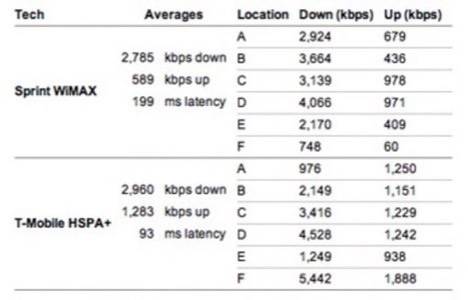Excited Sprint customers have been awaiting today’s release of the HTC Evo 4G – the first phone to take advantage of Sprint’s high-speed 4G network. Before you run out and drop some cash on an Evo, you may want to take a look at a study released today by mobile phone resource Phone Scoop which uncovered some surprising findings.

Phone Scoop found that Sprint’s 4G network is currently slightly slower than T-Mobile’s HSPA+ (High-Speed Packet Access) network – an upgraded form of 3G. After testing each service in Philadelphia (where both networks are currently available), the study determined that T-Mobile’s network has a small edge in download speeds, and a large advantage in upload speeds.
An important item the study notes is that no current network is actually “true 4G” – not even Verizon’s forthcoming LTE (Long Term Evolution) network. The International Telecomunication Union (ITU) requires 4G networks to provide download speeds of at least 100 mbps. Current high-speed networks only achieve roughly 3% of this speed, so “4G” is merely a marketing term used by Sprint and other networks to note that this is their fourth generation network.

While Sprint boasts speeds “up to ten-times faster” than 3G, T-Mobile’s upgraded 3G network was often faster in many of the more than 300 tests run by Phone Scoop. Download speeds were roughly the same, averaging at just under 3 Mbps, but with an upload average of 1.28 mbps, T-Mobile’s HSPA+ doubled that of Sprint’s 4G, which managed just 588 kbps. Sprint’s 4G, based on these tests, was less than five-times faster than its own 3G network, not ten.
The advantage T-Mobile has over Sprint is that its HSPA+ network was an upgrade to an existing in-place system, while Sprint’s 4G network requires new equipment, creating a slower roll out. This was exemplified in the study by Sprint’s dreadfully slower speeds in suburban areas. While T-Mobile managed a speedy 5.4 mbps down and 1.8 mbps up, Sprint’s “4G” could only muster 748 kbps down and 60 kbps up – closer to their 3G speeds.

Phone Scoop, while admitting that the testing is just one city’s results, is still confident the numbers reflect nationwide trends between the two networks. So before you buy into Sprint’s “4G speeds,” it would be wise to investigate the coverage in your area and determine if it is truly worth it at this time.
Another factor to consider is the number of devices available on each network. Currently, the Evo is the only Sprint device on the 4G network, while T-Mobile offers nine devices that can use HSPA+. Also, users more dependant on upload speeds (which affects media sharing, gaming or video chatting) may want to seriously consider T-Mobile over Sprint due to the networks blazing upload speeds. Either way, picking a phone is nearly as important picking a car, so smart shoppers should investigate the networks carefully before choosing.




















